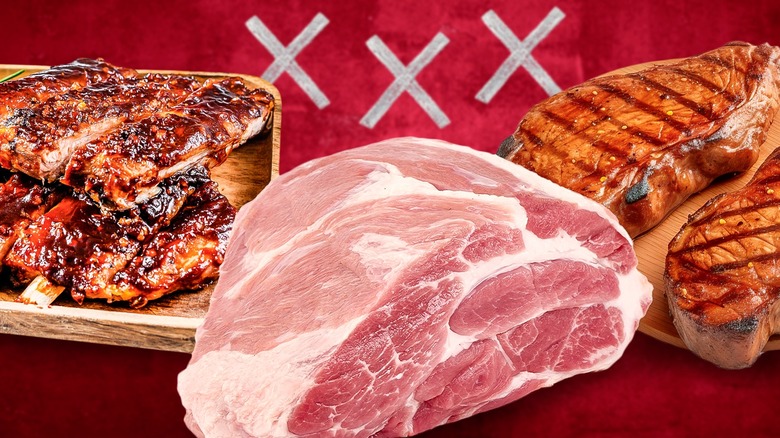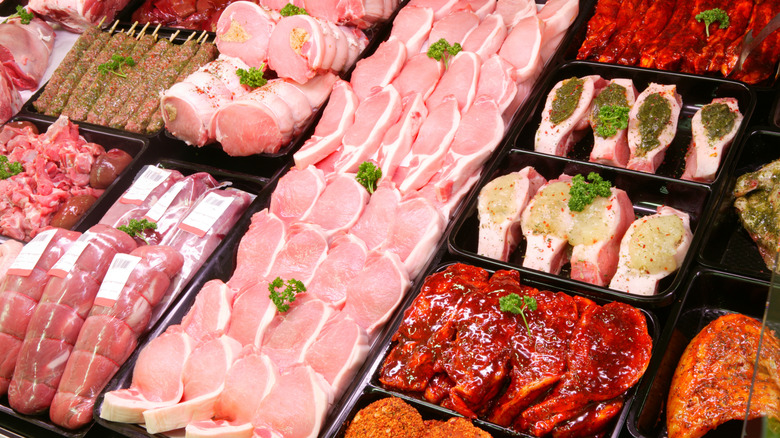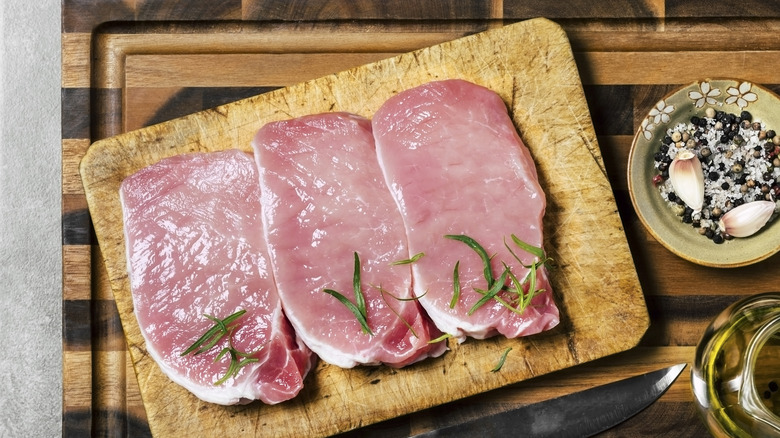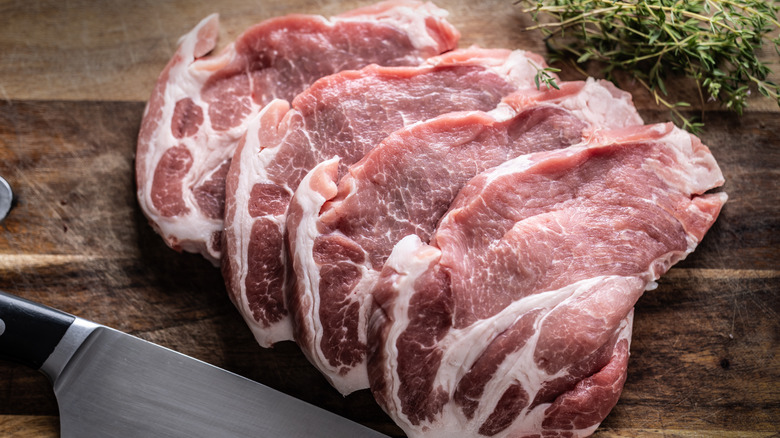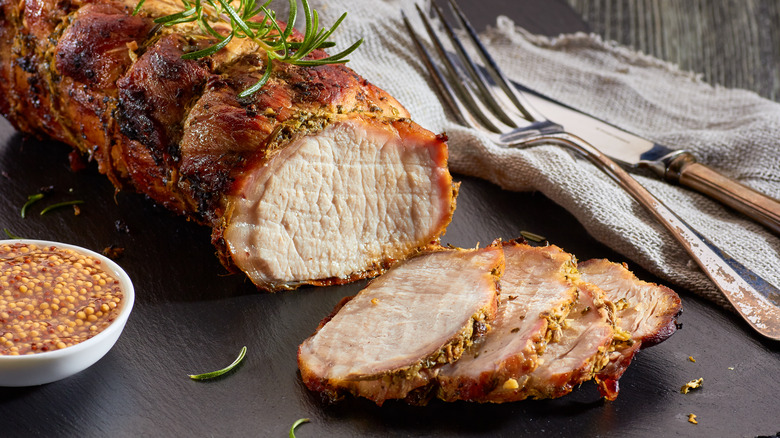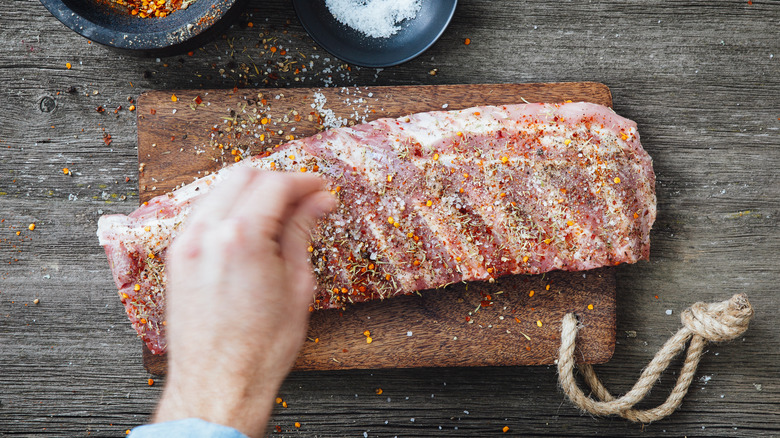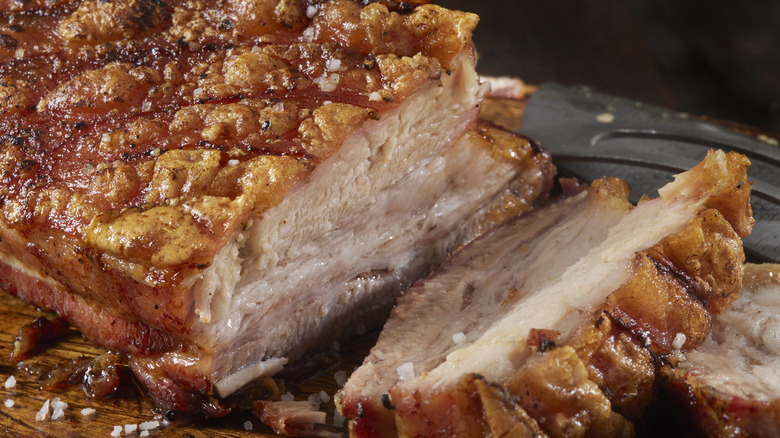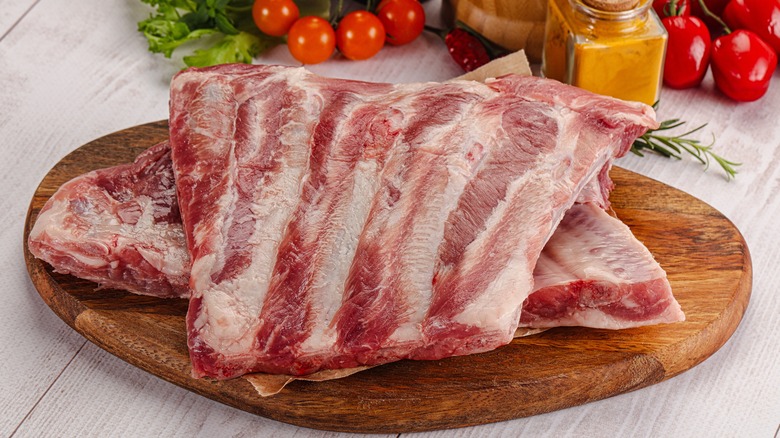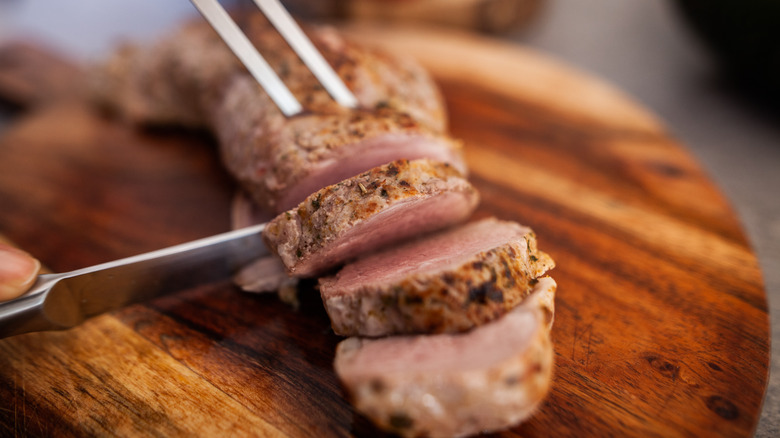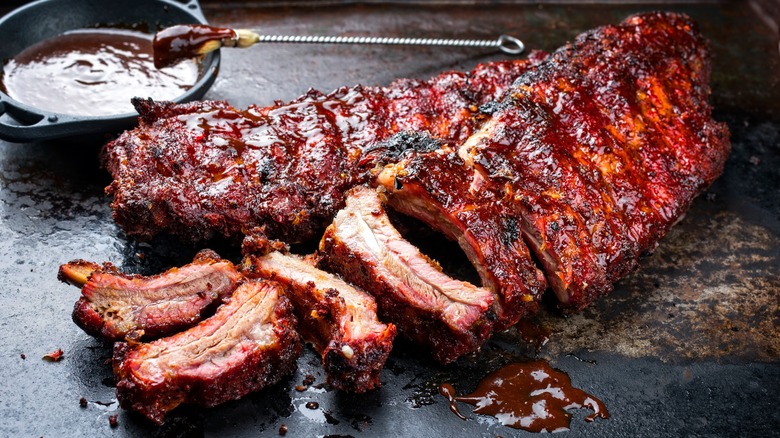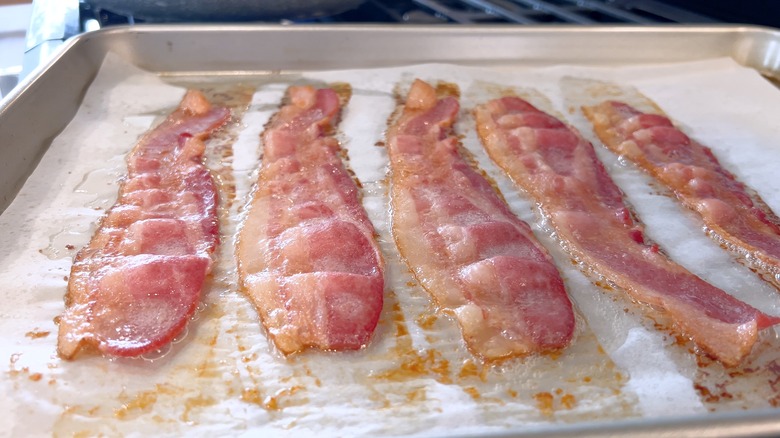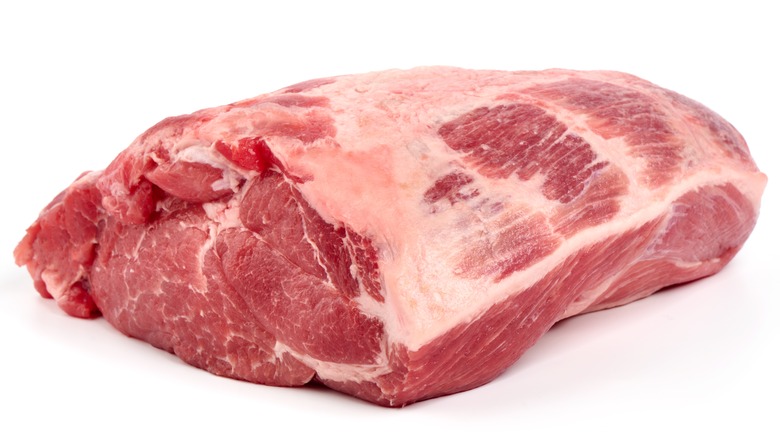Cooking Mistakes That Are Ruining Your Pork, According To Experts
Whether it's tender pulled pork sandwiches or the perfect pork chop, this delicious meat is a great choice for lunch or dinner. But before you fire up the grill or get your pan heated, it's important to know what to avoid when cooking pork.
We talked to butchers and chefs about the common mistakes that they see in the shop or the kitchen. Chef Jack Bennett, Executive Chef of International Smoke in San Francisco, weighed in on choosing the right cut and preparing it correctly for each dish, noting that some of the most crucial steps occur before you even start cooking. Rosangela Teodoro is a butcher, rancher, and owner at Teodora's Boucherie Gourmande, and provided us with some tips on making different cuts of pork and cooking for a crowd.
Both agreed that many of the mishaps they see can be prevented by knowing what cuts to choose, how to trim each piece, and the best seasoning methods. Paying attention to how long it cooks is also key to a delicious piece of pork that is juicy and full of flavor, since overcooking is one of the most common errors. Here are the biggest mistakes they pointed out.
Picking the wrong cut
The first thing that you'll need to decide when making pork is what type of dish you want to cook and what cut is best. If you choose the wrong cut — say, ribs when you want pulled pork, for example — it can be nearly impossible to get the texture and flavor that you want. Talking to the experts at the butcher counter is a great way to find out what they recommend and get the best cut. Share what type of dish you want to prepare as well as your preferred cooking method, such as grilling, pan searing, or smoking.
You can also let the size of your meal guide your selection. "Pork shoulder is a cheap and affordable way to cook for a large group of people with minimal effort, but when done correctly can result in a surprising end product!" says Chef Jack Bennett. "I look at pork shoulder as the everyday approachable way to smoke pork. The size of the shoulder is a bit forgiving because it will hold in a fair amount of moisture with all of the fat on top."
Always choosing boneless or thin cut
Rosangela Teodoro recommends talking to an expert about the thickness of your cut as well, including options for boneless or bone-in and how that will impact your preparation. "Talk to your butcher about your recipe to determine that ideal thickness for pork chops," she says. "For example, a big mistake is to order too thin. For the grill, an ideal thickness is 1.5-inches." Thin cuts cook faster than thick cuts, so take into account how much time you want to spend in the kitchen or by the grill when you make your selection.
She also adds that choosing a bone-in pork chop will need different cooking times than a boneless cut, which can be more difficult to keep juicy. "A bone helps meat cook fast so don't buy a thick chop," Teodoro says. But don't avoid bone-in cuts just because they take some extra attention. Some pork dishes are best when they're made with a bone-in cut of meat. The bone adds flavor and helps keep the meat moist, as well as allows you to better control the cooking process. Whether you choose bone-in or boneless, use a meat thermometer to get the most accurate readings and to tell when your pork is done cooking.
Removing all of the fat
Fat is necessary to keep the meat moist and adds plenty of flavor as well, so don't cut away all of the fat or buy cuts that are super lean. This is another area where talking to your butcher and having meat cut to order can help. If you're choosing meat from the butcher case, Chef Jack Bennett recommends looking for pork with plenty of marbling, or intramuscular fat.
Some cuts have a lot of fat on the outer edges, which you might be tempted to remove, but this eliminates both flavor and moisture needed during cooking. Fortunately, incorrectly preparing this type of pork is one of the easiest pork mistakes to remedy because it actually requires less work to leave the fat on rather than cutting it off. "The fat cap needs to have about ½ inch on it and should not be trimmed off," Rosangela Teodoro says. "The fat protects the cooking process and it bastes the pork, creating and keeping the meat juicer." Instead of trimming it before cooking, cut it off after cooking if necessary. This allows the fat to add flavor and keep the meat juicy while it cooks, but still discards residual chewy bits before you eat your dish.
Leaving on the membrane
Some cuts, such as pork tenderloin, come with a membrane that can be tough and chewy. This piece of tissue, also called the silver skin, remains on the pork as it cooks and shrivels, which can cause the pork to twist. Not only do you run the risk of uneven cooking, but it also interferes with the normally tender meat inside because the silver skin doesn't melt during the cooking process. Instead, it stays chewy and creates a gristly texture that is unpleasant at best and impossible to chew at worst. You are better off just removing it completely or asking the butcher to do it for you to get the most tender results.
Rosangela Teodoro told us that removing this membrane is key since it can negatively affect the texture of the meat. The membrane can also cause a tenderloin to curl up or cook unevenly, making a less tender final dish. You can cut it off with a sharp knife by pulling the membrane away from the meat and trimming it, discarding the silver skin in the trash. It's best to do this before you add marinade to keep the raw meat from becoming hard to handle.
Not using seasoning
Bland pork is often the result of under-seasoning, so don't be stingy with salt, pepper, and any spices that you want to add. Pork needs seasoning before cooking, especially if you're searing the outside over high heat, to create that flavorful crust. You can mix in other spices to bring additional flavors, add heat, or amp up the pork's natural flavor. You can also take inspiration from international flavors and try new ways to season and serve pork.
"When cooking, I like to simply season with salt, pepper, and lemon," Rosangela Teodoro says. "I also like to make a brine overnight, with rosemary, thyme, fresh garlic, salt, and pepper. You can marinate the pork chops in brine for a minimum of 1 hour or up to 8 hours." Brine also increases the moisture in the meat, which can help it from drying out during the cooking process.
Chef Jack Bennett adjusts his seasoning to the type of cut and fattiness. "For the fattier cuts of pork (pork belly, shoulder), the most important thing is to season heavily with salt," he says. "Fat and salt are the two most complimentary tastes when it comes down to it."
Forgetting the exterior
You might be tempted to put your pork roast right in the oven, slow cooker, or pressure cooker. But just like steak, searing the outside of your pork first will result in better flavor and a crispy exterior texture. This is especially important when you're cooking pork with the skin on. Chef Jack Bennett recommends taking this extra step when cooking pork belly. "Pork belly is a fatty, tender vessel for a lot of bold flavors. Skin-on pork belly is also something really special when the skin is properly crispy," he says. You can even make an entirely new dish by frying the skin. "Smoking pork belly is fun. If you want to experiment with curing salt you can make your own bacon or try smoking a skin on pork belly and frying the skin to make chicharrones."
On the other side of the spectrum is letting it sear too much over high heat. The outside can become burnt, especially if you're using a marinade or sauce, while the inside might still be raw. The best preparation depends on the cut, style, and what you want the dish to turn out as. High heat results in a crispier exterior, which is great for thin cuts, skin-on pork, or specialty dishes like chicharrones, which happen to be Bennett's favorite preparation for pork belly.
Letting the meat dry out
It's important to keep the meat moist as it cooks, whether from the fat of your specific cut, adding a marinade or sauce, or using another method specifically designed to keep the meat tender and juicy. This can be more difficult with certain cuts, so watch closely when working with pork cuts, such as ribs, with very little fat. This is why ribs often come slathered in barbecue or other sauces to make them extra juicy.
"Ribs can be really unforgiving if you over smoke or undercook them," says Chef Jack Bennett. "Keeping the ribs moist is also important here with the lack of fat compared to the shoulder." This is where a marinade can come in handy during preparation to add flavor and moisture, while sauce applied during and after cooking is another helpful trick. "To achieve balance with the leaner cuts, I tend to finish with a nice olive oil or sauce," says Bennett of seasoning the pork to add flavor. "If you are grilling pork chops in the summertime, marinate [them] in olive oil, oregano, and fennel seed. It will get you a light but satisfying balance." Just be sure to keep the two separate, since any marinade or sauce used on raw pork should be discarded and a fresh batch used to flavor the meat after cooking.
Overcooking or undercooking your pork
One common mistake when preparing any type of food is to cook it too much or too little. When it comes to pork, too little cooking can be dangerous while overcooking can make the meat inedible. The recommended internal temperature of pork is 145 F. If the internal temperature is far away from that, the meat may be tough and tasteless or pose a food safety risk.
Both Rosangela Teodoro and Chef Jack Bennett say that most people are more likely to overcook pork than undercook it, although chefs should be careful about both extremes. "The key with pork is not to overcook it, because it can become tough and dried out," says Teodoro. "Most people overcook pork!"
The chefs recommend using a meat thermometer to get pork that is in the right temperature range without letting it overcook. "Buy a meat thermometer if you want to be exact," recommends Bennett. "If you want to go by feel, it's a little less exact, obviously, but the firmness of the pork will tell you. If you press down in the center of whatever cut you're cooking, it should have resistance. A medium cook will have very little 'give.'" A raw or rare piece of meat, though, won't have much resistance and will keep the impression you've made even after you pressed into it. You should measure the meat at its thickest point to get the most accurate reading.
Slicing a freshly cooked tenderloin
If you don't let the meat rest, the juices that collect inside will run right out of the cut and you'll be left with dry pork. Instead, wait for a few minutes before cutting into it. Letting the meat rest allows the juices to soak back into the meat, which keeps them in your food and not running onto the cutting board. Resting pork between 5 and 20 minutes usually works well, depending on the thickness of the cut.
"I feel this is the most important part that people constantly overlook," Chef Jack Bennett says about resting meat after cooking. "You can do everything correctly to this point and ruin your entire experience by just cutting into it too early." He recommends letting the meat rest for around half the time that it spent cooking to maintain the moisture inside. Even a few minutes ensures that the juice stays with the meat, but it also means that your meat will continue cooking — another reason why overcooking on the grill or pan can be such a problem. Removing the meat from the heat at the right time and letting it rest is the key to juicy pork that is cooked just right.
Not finishing with sauce
Depending on the dish, you might need sauce or toppings to get the most flavor and add extra oomph to your pork. Barbecue sauce is a popular choice for pork, and there are plenty of styles to choose from that will give your dish flavor and moisture; you can even look for inspiration from different styles of cuisine. But you can also use glazes and dipping sauces to get a similar effect. Make sure to use a different batch of sauce for cooked meat than you did for a marinade on raw meat to prevent food contamination.
Chef Jack Bennett's favorite preparation of pork ribs includes an apple-soy glaze on top for a blend of sweet and umami-packed flavor. They are served at International Smoke as the restaurant's signature Korean-style ribs entree, one of his favorite ways to eat this cut of pork. The ribs are prepared in the wood-fired smoker and the glaze is applied generously on the top.
Limiting bacon to the pan
Bacon is a wildly popular way to eat pork that works for breakfast, lunch, or even as part of a dinner dish. Cooking it, though, can come with a lot of mess and cleanup. If you pour the bacon grease down the drain instead of disposing of it correctly, it might lead to plumbing issues that can be costly to fix. It makes sense, then, that one of the biggest mistakes that people make with bacon has more to do with the mess than the actual dish.
Fortunately, there are easy methods to make this delicious food easier to prepare. If you don't want to deal with the splatter and mess of frying bacon, consider cooking this breakfast staple in the oven. "When cooked in the oven, bacon can be cooked in large batches, and it tends to cook more evenly without hot spots or burnt edges," Rosangela Teodoro says. "The oven contains splatter better than a stovetop, making cleanup easier."
As long as there's enough space between each piece, it won't stick together and will come out crispy and delicious. It's important to give each strip of bacon enough room. Teodoro says that an overcrowded pan is the mistake most people make when it comes to bacon.
Assuming everyone eats it
It's important to note that not everyone eats pork, so make sure to check before bringing it as a shared dish. Whether it's a food allergy, lifestyle choice, or religious or cultural norm, there are plenty of reasons why some people avoid eating pork. Some cultures and religious guidelines even prohibit pork from being prepared alongside other food, so make sure to get the full rundown on food restrictions and preferences before hosting a get-together or bringing a dish. This can save time and make the experience more enjoyable for everyone.
Instead of assuming that pork will make a great appetizer or entree, ask your guests beforehand if this meat is the best option for a shared meal. You can always opt for multiple meat options as well as some savory vegetable choices to keep all of your guests happy and full. If you are grilling, be sure to make arrangements to reduce cross-contamination between pork and other types of meat or food.
"Try chicken or turkey," says Rosangela Teodoro. "Sometimes beef is a suitable substitute for certain pork cuts. Lamb can offer a unique flavor too. Fish or seafood works well in lighter dishes like tacos or stir-fries. Lastly, plant-based options like tofu, tempeh, or seitan can be used as a non-meat alternative, often mimicking pork's texture and flavor with the right seasoning."
